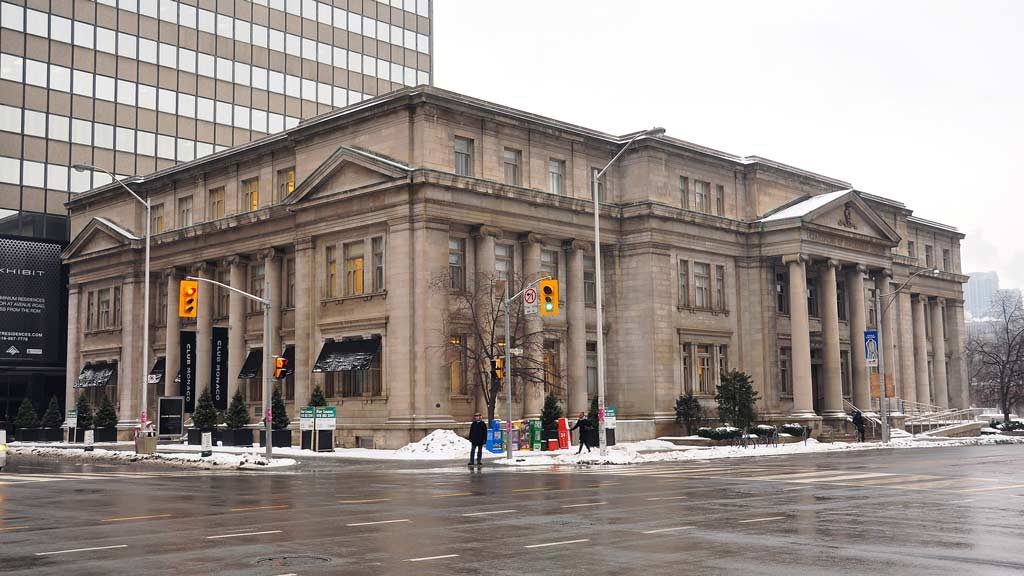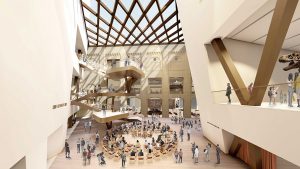Named after a member of a preeminent Canadian business/political and arts family and designed in the neo-classical style by architect George Miller, the landmark Lillian Massey Building in Toronto was the focus of a major restoration project recently.
A long list of selective Dutchman, smaller crack, and plastic repairs, masonry cleaning and repointing were completed on the Indiana limestone walls on the south, west, and north sides of the building which is located at the intersection of Bloor Street and Avenue Road just north of the Queen’s Park.
Designed and overseen by ERA Architects and undertaken by Heritage Restoration Inc. (HRI), the project also included a full-scale conservation of the building’s double-hung wooden windows.
“All buildings need maintenance,” says ERA principal Andrew Pruss in outlining the project’s detail and complexity and pointing out that it is one of a series of ongoing maintenance projects undertaken by Victoria University which owns the building.
(Victoria University is a Federated College within the University of Toronto.)
In this particular project, there was a considerable amount of work. It had to be conducted in three different stages between the fall of 2017 and the spring of this year because the building houses a number of different university departments and a retail store on the north side.
“It was a construction site on the outside, but the inside of the building is completely occupied,” says project architect Dominique Seydoux.
“Masonry work also can’t be performed if the weather is below 4 degrees Celsius.”
Besides the treatment of the Indiana limestone walls, some brick repointing in the courtyard of a less visible east-facing brick wall was also completed. For the most part the restoration proceeded in a clockwise motion beginning with the courtyard. But there were “overlapping times” when work was performed simultaneously on the east, south, and west sides and HRI had to bring extra scaffolding.
Repair work on the north (or Bloor Street) side was the “last and fastest” stage as part of a concentrated effort to minimize disruption to a high-end clothing retailer which leases that part of the building. As part of that effort, the contractor was able to ensure access to the store was maintained at all times, says Seydoux.
A major complication, at least in the early construction stage, was how to install a high-quality Lead Coated Copper (LCC) flashing along the profiled stone cornices at the roof level and the level below.
Cornice blocks, performing the role of shedding water from the masonry, were traditionally designed with the stone and mortar joints exposed to the elements. The cornice blocks features lugged mortar joints — which the architect describes as “little upstands” that raise the joints to mitigate excessive water run-off over the mortar.
Considered a “sacrificial building material”, mortar joints tend to erode more quickly than the stone. In the past they would have been regularly replaced as part of ongoing maintenance and, in the case of some buildings, there would be in-house masons.
Now, with significantly higher labour and access costs, ongoing mortar replacement doesn’t make sense and that’s the reason for installing durable, low-maintenance, and high quality lead coated copper flashing, Seydoux says.
The problem, however, was that the uneven profile of the lugs would have interfered with the installation of the “very rigid” copper flashing.
A number of remedial ideas were considered by both HRI and the architect including using wood blocks and even saw-cutting the lugs off.
“But we didn’t want to do that,” says Seydoux.
The solution proved to be the design and installation of raised cap flashing which sits snuggly over the lugged joints and allows for expansion joints to control the thermal movement of the copper flashing, he says.
The conservation of the approximately 200 double-hung sash windows involved the offsite repair of the windows sashes and the onsite repair of the jams, sills, and headers.
The masonry work and the window restoration were undertaken at the same time, but had to be phased properly to ensure worker safety and the highest quality finished product, says Heritage Restoration Inc. project manager Nate Geer.
Besides the masonry and window work, the project’s scope also included some sheet-metal and salvage and demolition work, plus the erection of the scaffolding which was done by HRI and was the primary means of access.
Working in an occupied building always has its challenges. But HRI worked very closely with and on a consistent basis with the tenants, owner and the consultant to ensure that all parties’ concerns were considered prior to starting and throughout the restoration, says Geer.
“It’s really important that we take care of our assets, especially the iconic ones,” says Victoria University’s physical plant director Vikas Mehta in commenting on the need for the project and others the institution has commissioned.
“Then there is the issue of sustainability, adds Mehta, citing the potential energy savings from the window conservation. Although it’s too early to quantify those savings, there have been less “draft complaints” from occupants.
Built between 1908 and 1913, the Lillian Massey Building is named in honour of educator and philanthropist Lillian Massey Treble who created the University of Toronto’s Department of Household Science and who was a member of the prominent Massey family.











Recent Comments
comments for this post are closed